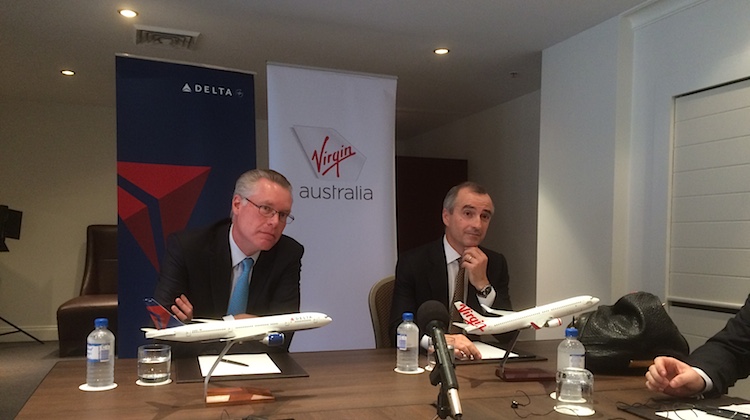
Virgin Australia and Delta Air Lines say the immediate objective of their trans-Pacific joint-venture is to consolidate existing routes rather than add new services.
Delta president Ed Bastien said his airline and Virgin have grown market share quickly since their partnership began in 2009 and the focus was on making sure that market share matured before adding incremental capacity.
“Our service is only five years old and I think we would like to make certain over time that we grow from a solid base of partnership before adding more flights,” Bastien told reporters after speaking at a business lunch in Sydney on Wednesday.
“At the present time we are going to keep what we’ve got and see how we can grow the market over time.”
In January, the pair applied to the Australian Competition and Consumer Commission (ACCC) to reauthorise their alliance, which kicked off in September 2011 and covered codesharing on each other’s services, reciprocal frequent flyer benefits, the ability to coordinate prices, schedules and routes as well as share revenue under the concept of “metal neutrality”.
Figures submitted to the ACCC as part of their submission highlighted Qantas’s dominance on the trans-Pacific market, with the Flying Kangaroo carrying 46.1 per cent of all passengers on the route in 2013, compared with Virgin and Delta’s combined share of 21.4 per cent.
Virgin Australia chief executive John Borghetti said it was unlikely his airline would be able to compete against the likes of Qantas and United – the two largest carriers on the route – were it not for access to Delta’s vast US network as part of their deep partnership.
“Separate we are insignificant players almost and you question – certainly from the Virgin side, I can’t talk for Delta – how viable would you be if we didn’t have this relationship,” Borghetti said.
“The only answer I can give you on that one is go back to before we had this relationship and see how brittle our operation was in America.”
Virgin, then known as V Australia, and Delta started flying between Australia and the US in 2009.
Currently, Virgin and Delta have 21 flights a week from Australia to the US – Virgin has a daily service from both Sydney and Brisbane to Los Angeles, while Delta flies daily from the NSW capital to Los Angeles.

In October 2014, Virgin ended its three days a week Melbourne-Los Angeles flight and boosted its Brisbane-Los Angeles offering to daily. Its withdrawal has been more than covered with United’s new direct Melbourne-Los Angeles service and and Qantas increasing its US schedule from the Victorian capital to 10 times a week, from daily.
Borghetti said Virgin offered a competitive schedule to the US, which he described as the biggest, most important market for Australia and “absolutely critical” to the airline.
“When you’ve got daily services that’s pretty competitive so you’re better off competing properly on routes rather than fragmenting your network and not competing properly on anything,” Borghetti said.
“We had to strengthen what we had, which was very fragile.
“We’ve gone a long way in doing that.”
Borghetti said the added competition Virgin and Delta brought to the market had been good for consumers, noting fares went down about 20 per cent when Virgin entered the market and dropped by a further 10 per cent since the alliance.
Moreover, having Delta as a partner helped shore up what was at the time a loss-making operation to the US.

“Four years ago, or five years ago, we were losing a lot of money on America. A lot of money on America,” Borghetti said.
“And we were operating nowhere near as competitive a schedule as we do today. The only reason that we do run a competitive schedule today, and let’s face it it is daily out of Sydney, daily out of Brisbane, that’s pretty competitive, the only reason that we are doing that, the only thing that has allowed us to do this, is this partnership.”
The ACCC said in January it expected to issue a draft determination in March or April, with a final decision expected by May or June.










